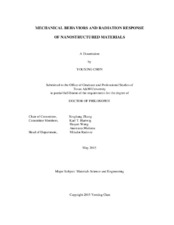| dc.description.abstract | Material performance in irradiation environments is central to the design of advanced nuclear reactors, which call for advanced materials that can sustain hundreds of displacements-per-atom (dpa) at elevated temperatures. Conventional coarse-grained materials cannot survive in such a challenging radiation environment. Nanostructured materials have gained increasing attention as they possess abundant boundaries/interfaces that may act as sinks for radiation-induced defects. The goal of this thesis is to investigate certain nanostructured materials to aggressively mitigate radiation damage, and achieve superior radiation tolerance. In particular we applied two strategies to alleviate radiation damage in Cu, which is often severely damaged under radiation environments, including the selection of Cu/Fe and Cu/Co multilayers with coherent immiscible layer interfaces and nanotwinned Cu with nanovoids.
Recent studies on metallic multilayers have shown that chemical immiscibility is important to achieve enhanced radiation tolerance. However the influence of coherency on radiation resistance of immiscible systems remains poorly understood. He ion irradiaton studies on Cu/Fe and Cu/Co multilayers suggest that coherent immiscible interfaces are also effective to alleviate radiaiton damage, and a prominent size effect is observed. In situ Cu ion irradiation study on Cu/Fe validates, for the first time, interface affected zone, that is defect density vary as a function of distance to the layer interface. Meanwhile we show, in He ion irradiated Cu/Co multilayers, a surprising size dependent strengthening behavior, that is films with smaller h have greater radiation hardening. Such unusual size dependent strengthening could be explained via a transition from partial dislocation transmission (before radiation) to full dislocation transmission (after radiation) dictated strengthening mechanisms due to formation of He bubbles at layer interface.
The second strategy involves the selection of nanotwinned Cu with nanovoids. In general radiation induced voids in irradiated materials grow continuously, manifested as void swelling. This study, however, describes a counterintuitive yet significant concept: deliberate introduction of nanovoids in conjunction with nanotwins enables unprecedented damage tolerance. In situ irradiation studies and atomistic simulations reveal that such remarkable self-healing capability in nanovoid-nanotwinned Cu stems from high density of twin boundaries that rapidly capture and transport defects to nanovoids, which store and eliminate defects.
Recent studies on metallic multilayers have shown that chemical immiscibility is important to achieve enhanced radiation tolerance. However the influence of coherency on radiation resistance of immiscible systems remains poorly understood. He ion irradiaton studies on Cu/Fe and Cu/Co multilayers suggest that coherent immiscible interfaces are also effective to alleviate radiaiton damage, and a prominent size effect is observed. In situ Cu ion irradiation study on Cu/Fe validates, for the first time, interface affected zone, that is defect density vary as a function of distance to the layer interface. Meanwhile we show, in He ion irradiated Cu/Co multilayers, a surprising size dependent strengthening behavior, that is films with smaller h have greater radiation hardening. Such unusual size dependent strengthening could be explained via a transition from partial dislocation transmission (before radiation) to full dislocation transmission (after radiation) dictated strengthening mechanisms due to formation of He bubbles at layer interface.
The second strategy involves the selection of nanotwinned Cu with nanovoids. In general radiation induced voids in irradiated materials grow continuously, manifested as void swelling. This study, however, describes a counterintuitive yet significant concept: deliberate introduction of nanovoids in conjunction with nanotwins enables unprecedented damage tolerance. In situ irradiation studies and atomistic simulations reveal that such remarkable self-healing capability in nanovoid-nanotwinned Cu stems from high density of twin boundaries that rapidly capture and transport defects to nanovoids, which store and eliminate defects. | en |


